Jet Stream Runs Swiftly Inside the Sun
|
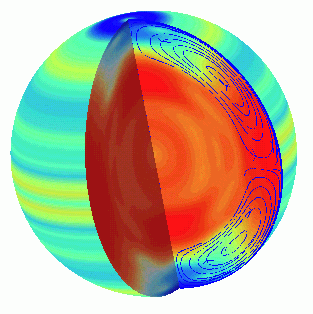
Larger Image (GIF) Larger Image (JPEG) |
See also: The NASA Press Release Site.
Scientists using the joint European Space Agency (ESA)/NASA Solar and Heliospheric Observatory (SOHO) spacecraft have discovered "jet streams" or "rivers" of hot, electrically charged gas called plasma flowing beneath the surface of the Sun. They also found features similar to trade winds that transport gas beneath the Sun's fiery surface.
These new findings will help them understand the famous sunspot cycle and associated increases in solar activity that can affect the Earth with power and communications disruptions. The new observations are the latest made by the Solar Oscillations Investigation (SOI) group at Stanford University, Palo Alto, CA, and they build on discoveries by the SOHO science team over the past year.
Press Release Full Text
Movies
A 235-frame video shows the solar sphere and various aspects of its rotation. Highlighted is the Sun's angular rotation, a cut-away displaying the internal rotation flows, the newly-discovered polar jets, and the polarward flow. The data are shown in false color projected onto a sphere.
- Solar Rotation (SGI) (30.1Mb SGI movie format)
- Solar Rotation (mpeg) (2.5Mb mpeg -- poorer colors but much smaller)
Still Images
(Extracted from the movie)
Higher resolution versions of the images are available from
Philip H. Scherrer
(650-723-1504)
or from Bill Steigerwald (301-286-8955).
Click on each image for a larger verson. Click on each figure caption for a more complete description.

Frame 1 | Frame 1 shows the solar sphere with angular rotation.
In these false-color images, the bulk of the Sun rotates
at the orange rate at about 30 degrees latitude.
Red represents faster than average flows, yellow is
slower than average, and blue is slower yet.
In the movie, frames 1-61 show the Sun turning to reveal a cut in the sphere. The sides of the cut show the rotation rate as it varies with depth and latitude.
|
|---|---|
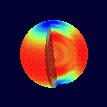
Frame 61 | Frame 61
begins a display of the primary results of this study.
The inner 70% or so of the Sun rotates at nearly the same rate.
However,there is marked differential rotation in the
outer 30%, which corresponds to the solar
convection zone
where the Sun's energy is carried upwards by convection rather
than by radiation.
Note the equator rotates much faster than the poles.
This frame also shows two interesting features that have recently been discovered with helioseismology. The first is a change in rate with depth, noted as a very thin yellow line just under the surface at nearly all latitudes. This corresponds to an increased rotation rate of about 200 mph. The second new discovery is a jet-stream at about 75 degrees latitude and about 25,000 miles below the surface. Look for a light blue oval surrounded by darker blue just under the surface of the slow blue polar region.
|
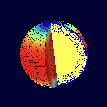
Frames 62-71 | Frames 62-71 show the streamlines of flow as they move
toward the poles.
The combination of differential rotation
and poleward flow has been the explanation for the contorted
shapes of magnetic field regions when the regions migrate
to the poles and get stretched to the left.
These new observations demonstrate for
the first time that the poleward flow is not just a
surface phenonenon, but a property of at least
12 percent of the convection zone.
|
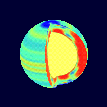
Frames 72-81 | Frame 72 to 81
show a different view of the Sun's rotation. Instead of
the general variation from the equator to the poles,
these frames demonstrate changes in speed rather than
the actual rotation rate. Red-yellow is faster than average
and blue is slower than average.
There are clear bands of faster and slower than average rotation. These bands persist through at least the upper 12,000 miles. Portraying the data this way highlights the smaller scale variations in the change in rotation from the equator to the poles.
|
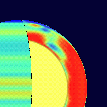
Frames 142-152 | Frames 142 to 152
zoom in for a close-up
of the solar interior, showing the difference in speed
between the local rotation and the smoothed surface rotation.
The polar jet stream and general speed-up just under
the surface are both more visible in this view.
The polar jet-stream shows as a red oval, indicating that is it not only faster than the material above around it but also distinctly slower (about 10%) than the surface above it. There is no hint of the jet on the surface. This feature was not expected and could not be detected without helioseismology techniques.
|
Grey images of stills
Higher resolution versions of the images are available from Philip H. Scherrer (650-723-1504) or from Bill Steigerwald (301-286-8955).
Background and Related Information
Includes additional images, publications, and other resources.
Authors and Contacts
Press Release N97-60, August 28, 1997
| Donald Savage
NASA Headquarters Washington, DC (Phone: 202/358-1547)
| Bill Steigerwald
Goddard Space Flight Center Greenbelt, MD (Phone: 301/286-8955)
|
|
Philip H. Scherrer
|
SOI Home Page
SOHO Home Page
|
Some Reports in the Media
|
Scientific American
|
Time Magazine
|
|---|---|
|
Bill Tammeus, via New York Times News Service
Why should Chelsea worry about SOI? | |
|
Washington Post
| Science News |
|
Science Magazine
(5 Sept 97, p 1438)
| |
|
NPR Sounds Like Science
|
CNN Sci-Tech
|
|
FLORIDA TODAY Space Online
|
San Francisco Chronicle
|
|
Philadelphia Inquirer
|
de Volkskrant (Holland)
|
| TV Coverage | |
| The Associated Press, August 29, 1997 | Agence France Presse, August 29, 1997 |
| The New York Times, August 29; 1997 | The San Francisco Chronicle, August 29, 1997 |
| Chicago Tribune, August 29, 1997 | The San Jose Mercury News, August 29, 1997 |
| USA TODAY, August 29, 1997 | Cleveland Plain Dealer |
| The Saginaw News (Michigan) | |
Research has been supported financially at Stanford University by the National Aeronautics and Space Administration (NASA) through Grant NAG5-3077. This grant supports Mission Operations and Data Analysis of the Solar Oscillations Investigation Michelson Doppler Imager instrument on the SOlar and Heliospheric Observatory (SOHO). The SOlar and Heliospheric Observatory (SOHO) is a mission of international cooperation between ESA (the European Space Agency) and NASA.
The MDI instrument was designed and built by the Solar Oscillations Investigation Team at Stanford University and the Lockheed-Martin Palo Alto Research Laboratory.
Created by Deborah Scherrer
This page is http://soi.stanford.edu/press/ssu8-97
Last Updated: 8 Dec 1997
 Back To SOI Home Page
Back To SOI Home Page